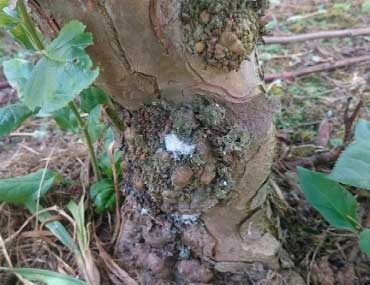Insecticide field trials.
Fruit Grower Victoria conducted field trials in 2015–16 for the 'Future Orchards Project', with different applications of insecticides for the control of woolly aphid.
In these trials we compared foliar applications, root drenching and a combined application of both treatments.
Foliar application
Foliar application of insecticides for the control of woolly aphid is commonly used.
There are number of active ingredients registered for this purpose. Some are used while the trees are in leaf (while the colonies are present on the tree) and some (those that are less selective with high toxic and residual properties) are used during dormancy.
To satisfy IPM principles of woolly aphid control and achieve eradication, some criteria must be satisfied. The insecticide must have:
- Good efficacy on woolly aphid
- Good selectivity on predators
- Achieve good contact with the pest.
Considering that the waxy covering and honeydew provide protection from some insecticides, this barrier needs to be broken by lowering the surface tension. Therefore a tank mix of insecticide and surfactant was used.
Efficacy
In this trial, for root drenching we compared the two most commonly used insecticides, imidacloprid and spirotetramat.
Due to physical-chemical properties such as low partition coefficient n-octanol/water, high leaching potential (low Koc between 132–310 and high water solubility of 514 ppm; up to 60 cm deep) and good persistence in the soil (persistence in soil (DT50=188–997 days)) we achieved good penetration onto soil and root system and systemic action.
The efficacy on the canopy was 100%.
On the base of the trunk, the situation was little different. Considering that systemic insecticides could not penetrate bark, and the fact that they move too quickly to upper parts, only contact efficacy has been achieved with 90% of efficacy on the base of the trunk.
Soil drenching
Failure to control aerial infestations can result in underground infestations on susceptible rootstocks.
In order to control root colonies, insecticides registered for use as a soil drench should be applied.
A soil drench can be used on trees up to seven years old.
(continued next month)
See this article in Tree Fruit March 2017




















